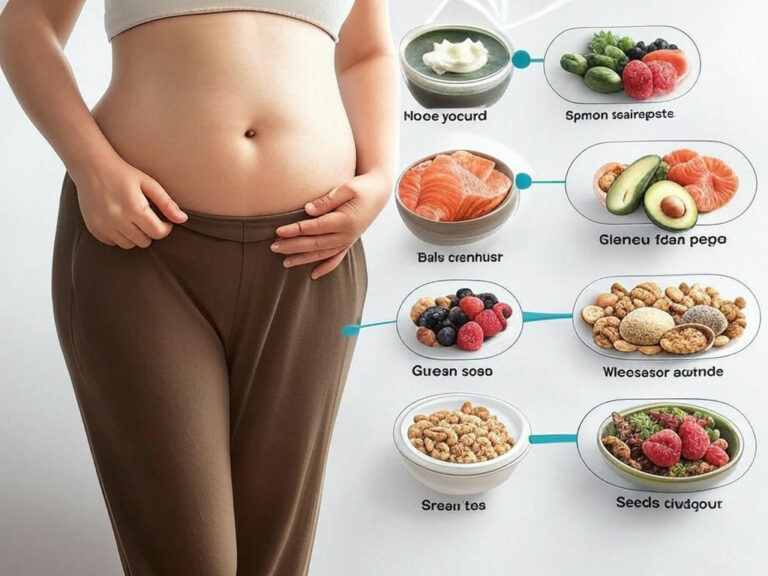How Aging and Hormones Drive Belly Fat — And What You Can Do About It
As we age, the human body undergoes a series of complex changes that can significantly influence body composition, particularly the accumulation of belly fat. This stubborn fat, often concentrated around the midsection, is not just a cosmetic concern but a health risk linked to serious conditions like heart disease, type 2 diabetes, and certain cancers. Two key factors driving this phenomenon are aging and hormonal changes, which interact in intricate ways to promote fat storage, especially visceral fat—the dangerous type that surrounds internal organs. This article explores how these factors contribute to belly fat accumulation, the underlying mechanisms, and evidence-based strategies to manage it.
The Role of Aging in Belly Fat Accumulation
Aging naturally alters the body’s metabolism, muscle mass, and fat distribution, creating a perfect storm for belly fat gain. As early as the 30s, metabolic rate begins to slow, reducing the number of calories burned at rest. This decline, coupled with a gradual loss of muscle mass (known as sarcopenia), means the body requires fewer calories over time. Without adjustments to diet or activity levels, excess calories are stored as fat, often in the abdominal region.
Recent research has shed light on a cellular mechanism contributing to this process. A 2025 study identified CP-A stem cells, a type of progenitor cell in adipose tissue, as a key player in age-related belly fat accumulation. These cells become more active with age, promoting the formation of new fat cells in the abdominal area. This discovery highlights why middle age is often associated with a thickening waistline, even in individuals who maintain consistent lifestyle habits.
Moreover, aging affects fat distribution. While younger individuals may store fat more evenly across the body, older adults tend to accumulate it centrally, particularly as visceral fat. This shift is partly due to changes in fat cell function and reduced fat-burning efficiency, making the abdomen a preferred storage site.
Hormonal Changes and Their Impact
Hormonal fluctuations are a hallmark of aging and play a central role in belly fat accumulation. Several hormones, influenced by age and lifestyle, contribute to this process:
- Estrogen Decline in Women
In women, the transition to menopause (typically between ages 45 and 55) brings a sharp decline in estrogen levels. Estrogen helps regulate fat distribution, favoring storage in the hips and thighs during reproductive years. As estrogen drops, fat redistribution occurs, with a greater proportion stored as visceral fat in the abdomen. This explains why post-menopausal women often notice a sudden increase in belly fat, even without significant weight gain.
Studies show that estrogen deficiency also impairs fat metabolism, reducing the body’s ability to break down stored fat. Additionally, lower estrogen levels are linked to insulin resistance, a condition where cells become less responsive to insulin, leading to higher blood sugar and increased fat storage, particularly in the belly.
- Testosterone Decline in Men
Men experience a gradual decline in testosterone starting in their 30s, with levels dropping about 1% per year. Testosterone supports muscle mass and fat metabolism, so its reduction leads to decreased muscle and increased fat storage. Low testosterone is strongly associated with visceral fat accumulation in men, contributing to the “dad bod” phenomenon. It also exacerbates insulin resistance, creating a feedback loop that promotes further fat gain.
- Cortisol and Stress
Aging often brings increased stress, whether from lifestyle changes, health concerns, or caregiving responsibilities. Chronic stress elevates cortisol, a hormone produced by the adrenal glands. Cortisol promotes fat storage in the abdominal area by mobilizing energy stores and redirecting them to visceral fat. This is an evolutionary adaptation to store energy near vital organs during stress, but in modern contexts, it contributes to belly fat.
Sleep deprivation, common in older adults, further amplifies cortisol levels. Research indicates that inadequate sleep (less than 7 hours per night) disrupts appetite-regulating hormones like leptin and ghrelin, increasing hunger and fat storage, particularly in the abdomen.
- Insulin Resistance
Insulin resistance becomes more prevalent with age, driven by hormonal changes, reduced physical activity, and poor diet. When cells resist insulin, the body produces more to compensate, leading to elevated insulin levels that promote fat storage, especially visceral fat. Social media discussions on platforms like X frequently highlight insulin resistance as a “hidden driver” of belly fat, emphasizing its role as an inflammatory organ that worsens metabolic health.
- Growth Hormone and Other Factors
Growth hormone, which supports muscle growth and fat breakdown, declines with age. This reduction impairs the body’s ability to burn fat, contributing to abdominal fat gain. Similarly, changes in thyroid hormones, which regulate metabolism, can slow calorie burning and promote weight gain in older adults.
Health Implications of Belly Fat
Visceral fat is metabolically active, releasing inflammatory molecules that increase the risk of chronic diseases. According to the National Institutes of Health, a waist circumference over 35 inches for women or 40 inches for men indicates elevated health risks, even in those with a normal body mass index (BMI). Key risks include:
Cardiovascular Disease: Visceral fat contributes to plaque buildup in arteries, raising the risk of heart attack and stroke.
Type 2 Diabetes: Insulin resistance driven by belly fat impairs blood sugar control.
Cancer: Excess visceral fat is linked to higher risks of breast, colorectal, and other cancers.
Metabolic Syndrome: A cluster of conditions including high blood pressure, high blood sugar, and abnormal cholesterol levels, often tied to abdominal obesity.
Strategies to Combat Age-Related Belly Fat
While aging and hormonal changes are inevitable, targeted lifestyle interventions can mitigate belly fat accumulation and improve health outcomes. Here are evidence-based strategies:
- Optimize Diet
Focus on Whole Foods: Emphasize vegetables, fruits, lean proteins, whole grains, and healthy fats (e.g., avocados, nuts). These foods stabilize blood sugar and reduce insulin spikes.
Increase Soluble Fiber: Foods like oats, beans, and apples (providing 7–10 grams of soluble fiber daily) can modestly reduce waist circumference by promoting satiety and improving gut health.
Limit Refined Carbs and Sugars: Avoid sugary drinks, white bread, and processed snacks, which contribute to insulin resistance and fat storage.
Moderate Alcohol: Excessive alcohol, particularly beer, is linked to visceral fat. Limit intake to one drink per day for women or two for men.
- Exercise Regularly
Combine Aerobic and Strength Training: Aim for 150 minutes of moderate aerobic activity (e.g., brisk walking, cycling) weekly, paired with two strength-training sessions to preserve muscle mass and boost metabolism.
High-Intensity Interval Training (HIIT): Short bursts of intense exercise can effectively target visceral fat, even in older adults.
Stay Active: Incidental movement, like standing or walking breaks, helps counteract sedentary habits that exacerbate fat gain.
- Manage Stress and Sleep
Stress Reduction: Practices like yoga, meditation, or deep breathing lower cortisol levels, reducing fat storage.
Prioritize Sleep: Aim for 7–9 hours of quality sleep nightly to regulate appetite hormones and support metabolic health.
- Monitor Hormonal Health
Medical Evaluation: Consult a healthcare provider to assess hormone levels (e.g., thyroid, insulin, or sex hormones). Hormone replacement therapy (HRT) may be considered for some menopausal women, but it carries risks and requires careful evaluation.
Address Insulin Resistance: Work with a doctor or dietitian to manage blood sugar through diet, exercise, or medication if needed.
- Avoid Quick Fixes
Beware of products claiming to target belly fat, such as pills, patches, or teas. The Federal Trade Commission’s “Operation Big Fat Lie” (2025) warns against deceptive weight-loss scams. Sustainable changes to diet and lifestyle are the only proven methods for reducing visceral fat.
Emerging Research and Future Directions
The discovery of CP-A stem cells as a driver of age-related fat accumulation opens new avenues for research. Scientists are exploring therapies to inhibit these cells’ activity, potentially offering targeted treatments for belly fat in the future. Additionally, studies are investigating the role of gut microbiota in fat storage, with preliminary evidence suggesting that probiotics or dietary interventions could influence visceral fat levels.
Conclusion
Aging and hormonal changes are powerful drivers of belly fat accumulation, reshaping metabolism and fat distribution in ways that increase health risks. Declining estrogen, testosterone, and growth hormone, coupled with rising cortisol and insulin resistance, create a challenging environment for maintaining a healthy waistline. However, proactive steps—such as a nutrient-dense diet, regular exercise, stress management, and adequate sleep—can significantly mitigate these effects. By understanding the interplay of aging and hormones, individuals can take informed steps to reduce visceral fat and protect long-term health. For personalized guidance, consulting a healthcare provider or nutritionist is essential, particularly for addressing hormonal imbalances or assessing visceral fat through waist measurements or medical tests.”






